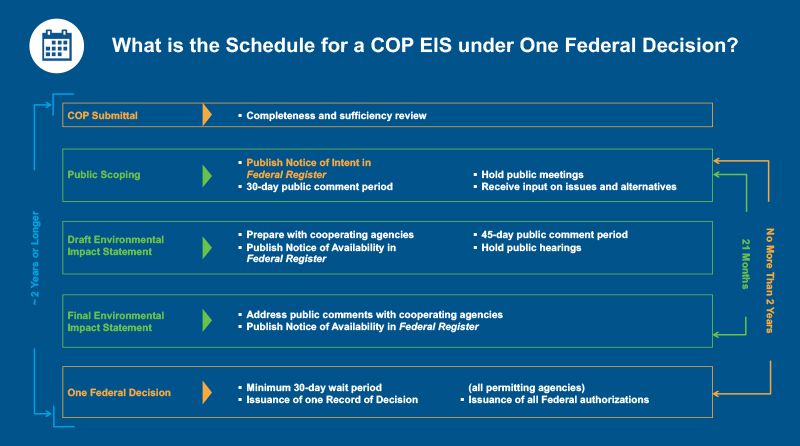
Offshore wind development: How to navigate the environmental permitting sea change
The U.S. offshore wind market is poised to expand greatly in the near future. While there is only one operating offshore windfarm in the U.S. at this time, commitments from states and the Federal government are paving the way for the creation of offshore wind projects on both coasts. As the offshore wind market gains traction, the current Administration is seeking to streamline the environmental review and permitting process, focusing on laws such as the National Environmental Policy Act (NEPA), the Endangered Species Act (ESA), the Migratory Bird Treaty Act, the Clean Air Act, and the Clean Water Act.
In streamlining environmental review and permitting, the goal is to advance more timely decision-making on proposed projects by requiring more concise NEPA documents be prepared under aggressive timeframes. These streamlining efforts may offer developers more assurance regarding project approval timeframes and construction schedules. However, these efforts to streamline environmental documents and approval processes need to be balanced with meeting the requirements of NEPA and other environmental regulations while also creating a solid administrative record to withstand legal challenges.
Some of these new directives are overlapping while others continue to evolve, creating uncertainty within the industry. Preparing compliant NEPA documents under compressed timeframes and meeting the myriad of new directions presents an unprecedented challenge for all involved—Bureau of Ocean Energy Management (BOEM), its cooperating agencies, its contractors, and offshore wind developers.
Primary directives regulating offshore wind development
The following directives provide alternate avenues for expediting environmental reviews of infrastructure projects. Understanding these regulatory changes will help offshore wind project developers anticipate the needs of federal decision makers while they develop the supporting information and technical studies that will help inform BOEM’s environmental review under NEPA.
1. Department of Interior Secretarial Order 3355: This Department of Interior Order establishes page and time limits for NEPA reviews. The relevant provision for a Construction and Operation Plan (COP) Environmental Impact Statements (EIS) is the 150-page limit (excluding appendices). While there is the option of exceeding the page limit for “unusually complex projects,” this requires high-level approval and justification.
2. One Federal Decision: Executive Order 13807 established an approach entitled One Federal Decision (OFD) for use with major infrastructure projects. In April 2018, 12 federal agencies, including the Department of Interior, signed the OFD Memorandum of Understanding (MOU) establishing a process for improving the coordination and timeliness of environmental reviews of major infrastructure projects.
The OFD benefits offshore wind developers by providing:
- a single EIS and record of decision (ROD) with a 90-Day authorization deadline.
- concurrent agency reviews and a limit on agency comments to issues that are within the agency’s area of expertise or jurisdiction.
- a ROD issued within two years of the Notice of Intent.
- established agency concurrence points.
- timely elevation of inter-agency disputes.
- schedule extensions limited to:
- the authorizing agency’s “special circumstances” or applicable law making a two-year schedule impracticable.
- developer requests for a schedule change.
- when developers are unresponsive, the agency may change the schedule.
3. Title 41 of the Fixing America’s Surface Transportation Act: Also known as FAST-41, this directive includes measures to streamline environmental reviews for infrastructure projects. Under FAST- 41, a developer’s responsibility is to submit a complete Initiation Notice, consult on the permitting timetable, and demonstrate technical and financial capability.
The unique benefits associated with FAST-41 include:
- oversight via the Federal Permitting Improvement Steering Council and the Chief Environmental Review and Permitting Officer.
- greater transparency through the FAST-41 Permitting Dashboard.
- litigation limits via the two-year statute of limitations.
- NEPA litigation claims limited to prior relevant comments during the project’s environmental review.
Looking forward
So, what additional environmental regulatory changes are on the horizon? The U.S. Fish and Wildlife Service and National Marine Fisheries Service published three proposed rules that would revise the regulation implementation sections of the ESA.
The proposed rules would change the criteria and procedures for three key activities:
- establishing protections for “threatened” species.
- listing and delisting of species and the designation of critical habitat.
- interagency consultation process under ESA Section 7.
Additionally, Council on Environmental Quality (CEQ) is in the process of updating its NEPA implementing regulations. CEQ has solicited public comments on recommended revisions to the regulations to promote a more efficient, timely, and effective process.
The environmental permitting process and requirements continue to evolve for all major infrastructure projects, requiring close monitoring to be able to effectively and efficiently navigate the changes. ICF’s team of environmental permitting experts keep a constant finger on the pulse of these changes and will provide updates as they are available. If you have questions on these or other offshore wind topics, we encourage you to reach out to our team and ask.
